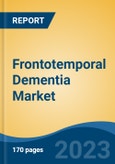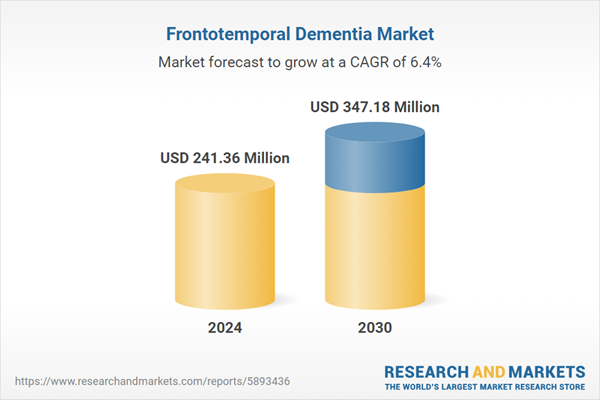Free Webex Call
The Frontotemporal Dementia Market was valued at USD 241.36 Million in 2024, and is expected to reach USD 347.18 Million by 2030, rising at a CAGR of 6.39%. Frontotemporal diseases are a neurological condition characterized by the degeneration of nerve cells in the frontal or temporal lobes of the brain. This condition, which includes dementia, progressive supranuclear palsy, and primary progressive aphasia, significantly impacts behavior, language, movement, and personality, thereby impairing individuals' ability to perform daily activities. Frontotemporal disorders, also known as frontotemporal lobar degeneration, are a type of brain disorder that primarily affects the frontal and temporal lobes. This condition is characterized by the progressive loss of nerve cells and the development of dementia. Speak directly to the analyst to clarify any post sales queries you may have.
10% Free customizationThis report comes with 10% free customization, enabling you to add data that meets your specific business needs.
For instance, a 2025 study from Finland compared epilepsy prevalence and antiseizure medication use among 245 frontotemporal dementia (FTD) patients, over 1,300 Alzheimer’s disease (AD) patients, and more than 2,400 age-, sex-, and location-matched healthy controls. FTD patients had a mean diagnosis age of 65 (49% women), while AD patients averaged 72 years (59% women). The typical age range for the onset of frontotemporal disorder is between 40 and 60 years, although it can occur after the age of 60. Following diagnosis, the average life expectancy is approximately 8-10 years. Given its significant impact on the healthcare sector, it is projected that frontotemporal disorders will experience substantial growth in the forecast period.
Key Market Drivers
Increasing FTD Drug Development and Increasing Funds
Non-profit organizations and disease advocacy groups, as well as private organizations, are currently focused on supporting the development of drugs for Frontotemporal Degeneration (FTD) due to the expanding patient population. Research funding initiatives from notable non-profit organizations, such as the Association for Frontotemporal Degeneration (AFTD), Bluefield Project Organization, Tau Consortium Organization, Alzheimer Discovery Foundation (ADDF), and CurePSP, Inc., have played a significant role in stimulating research efforts for the treatment of frontotemporal disorders.These organizations provide support for both clinical and preclinical trials aimed at testing novel therapeutics that can intervene to slow down or halt the progression of FTD and other rare neurological diseases. This, in turn, contributes to the growth of the market. For instance, a 2025 study revealed that epileptic seizures are significantly more common in patients with frontotemporal dementia (FTD) than previously believed. This finding enhances understanding of FTD symptoms and highlights the need to consider seizures in patient care. Led by Neurocenter Finland, the University of Eastern Finland and University of Oulu conducted the research, published in JAMA Neurology, using one of the world’s largest FTD datasets.
Grants and funding provide resources to support FTD-focused research initiatives. This includes investigations into the underlying mechanisms of the disease, identification of potential drug targets, and the development of novel therapeutic approaches. Drug development in FTD necessitates rigorous clinical trials to evaluate the safety and efficacy of potential treatments. Grants and funding support the design, implementation, and monitoring of these trials, facilitating the testing of new therapies. Adequate funding enhances the attractiveness of FTD research for scientists and researchers.
This can lead to increased participation, collaboration, and expertise focused on FTD drug development efforts. Funding enables the exploration of innovative therapeutic strategies, including small molecules, biologics, gene therapies, and personalized medicine approaches tailored to the unique characteristics of FTD patients. Grants and funding assist in the identification and validation of promising drug targets for FTD. This step is crucial in developing treatments that address the underlying causes of the disease.
Key Market Challenges
Misdiagnosis of Neurological Disorders
Multiple frontotemporal disorders are frequently misdiagnosed as depression, Parkinson's disease, Alzheimer's disease, or other psychiatric conditions. This hinders the potential for implementing appropriate treatment for neurological conditions. Misdiagnosis often leads to delayed initiation of appropriate treatment for the underlying FTD. This can result in missed opportunities for interventions that could slow disease progression or manage symptoms effectively. Treating FTD patients based on misdiagnosed conditions can result in ineffective or even harmful treatments. Medications commonly used for depression or other psychiatric disorders may not address the specific cognitive, behavioral, and functional challenges of FTD.Without proper treatment, FTD symptoms can worsen over time, leading to greater impairment in daily functioning and quality of life. Misdiagnosis can lead to unnecessary medical expenses, as well as wasted time and resources on treatments that are unlikely to be effective. Accurate diagnosis is crucial for enrolling eligible patients in clinical trials for FTD-specific treatments. Misdiagnosis can exclude patients from potential participation and hinder the development of targeted therapies.
Key Market Trends
Higher Drug Approvals and Advanced Treatment
Several antidepressant drugs are utilized for the treatment of major depressive disorders and other conditions, such as dysthymia, obsessive-compulsive disorder (OCD), anxiety disorders, eating disorders, chronic pain, and neuropathic pain. For example, in October 2018, Lundbeck introduced Brintellix tablets for the treatment of Major Depressive Disorder in India. Similarly, in April 2019, Lupin launched antidepressant Fluoxetine tablets in the American market, specifically for the treatment of major depressive disorder and obsessive-compulsive disorder. These initiatives contribute significantly to the growth of the market.Drug approvals provide patients with access to treatments that can potentially slow down disease progression, manage symptoms, and improve quality of life. This leads to higher demand for treatments among FTD patients and healthcare providers. Effective treatments often come with improved diagnostic methods, biomarkers, and screening tools. This facilitates early diagnosis and patient identification, leading to an increased pool of eligible patients seeking treatment. Approved treatments can contribute to better patient outcomes, including improved cognitive function, reduced behavioral symptoms, and enhanced daily functioning.
Positive outcomes drive higher demand for these treatments. Drug approvals garner media attention and raise awareness among patients, caregivers, and the general public. This increased awareness leads to more individuals seeking diagnosis and treatment options for FTD. Successful drug approvals indicate a growing interest in FTD research and development. This encourages pharmaceutical companies, researchers, and investors to invest more resources into finding innovative treatments.
Key Market Players
- Transposon Therapeutics
- Alector Inc.
- Denali Therapeutics Inc.
- Pfizer Inc.
- Johnson & Johnson Services Inc.
- Prevail Therapeutics
- Wave Life Sciences
- AstraZeneca plc
- GlaxoSmithKline plc
- TauRx Pharmaceuticals Ltd.
Report Scope:
In this report, the Global Frontotemporal Dementia Market has been segmented into the following categories, in addition to the industry trends which have also been detailed below:Frontotemporal Dementia Market, By Drug Class:
- Cognitive Enhancers
- Antipsychotics
- Antidepressants
- CNS Stimulants
- Other Drug Classes
Frontotemporal Dementia Market, By Disease Indication:
- Frontotemporal Dementia
- Primary Progressive Aphasia
- Movement Disorders
Frontotemporal Dementia Market, By Distribution Channel:
- Hospital Pharmacies
- Retail Pharmacies
- Online Pharmacies
Frontotemporal Dementia Market, By Region:
- North America
- United States
- Canada
- Mexico
- Europe
- France
- United Kingdom
- Italy
- Germany
- Spain
- Asia-Pacific
- China
- India
- Japan
- Australia
- South Korea
- South America
- Brazil
- Argentina
- Colombia
- Middle East & Africa
- South Africa
- Saudi Arabia
- UAE
Competitive Landscape
Company Profiles: Detailed analysis of the major companies present in the Global Frontotemporal Dementia Market.Available Customizations:
With the given market data, the publisher offers customizations according to a company's specific needs. The following customization options are available for the report.Company Information
- Detailed analysis and profiling of additional market players (up to five).
This product will be delivered within 1-3 business days.
Table of Contents
1. Product Overview
2. Research Methodology
3. Executive Summary
5. Clinical Trial Analysis
6. Global Frontotemporal Dementia Market Outlook
7. North America Frontotemporal Dementia Market Outlook
8. Europe Frontotemporal Dementia Market Outlook
9. Asia-Pacific Frontotemporal Dementia Market Outlook
10. South America Frontotemporal Dementia Market Outlook
11. Middle East and Africa Frontotemporal Dementia Market Outlook
12. Market Dynamics
13. Market Trends & Developments
15. Porter’s Five Forces Analysis
16. Competitive Landscape
Companies Mentioned
- Transposon Therapeutics
- Alector Inc.
- Denali Therapeutics Inc.
- Pfizer Inc.
- Johnson & Johnson Services Inc.
- Prevail Therapeutics
- Wave Life Sciences
- AstraZeneca plc
- GlaxoSmithKline plc
- TauRx Pharmaceuticals Ltd.
Table Information
| Report Attribute | Details |
|---|---|
| No. of Pages | 185 |
| Published | July 2025 |
| Forecast Period | 2024 - 2030 |
| Estimated Market Value ( USD | $ 241.36 Million |
| Forecasted Market Value ( USD | $ 347.18 Million |
| Compound Annual Growth Rate | 6.3% |
| Regions Covered | Global |
| No. of Companies Mentioned | 10 |









